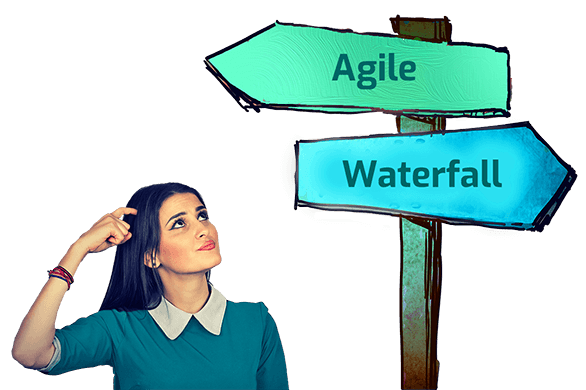

Agile vs. waterfall: The tale of two road trips!

Imagine you're planning a road trip. The goal is to reach an amazing destination, but the journey could look very different depending on whether you take the Waterfall route or the Agile approach.
Waterfall: The strictly planned road trip
Waterfall is like plotting out your road trip on a map, setting your route in stone, and making sure every single stop is pre-planned before you leave.
Planning phase: You carefully map out every exit, rest stop, and scenic overlook. The trip is locked in, and there’s no room for changes. You know exactly when you’ll stop for fuel and where you’ll eat lunch."No, we are NOT changing the route because you want to check out that cool beach! We’ll stick to the plan!"
Execution phase: You hit the road, following your exact schedule. Every milestone is a set point on your map, and nothing deviates. If you hit a detour or traffic, you must follow the backup route—but that could throw everything off.
Delivery phase: You arrive at your destination at the scheduled time, having followed the exact path laid out. The journey might have been predictable, but you can feel proud that you stuck to the plan.
Waterfall works best if:
- You know exactly where you're going and how to get there.
- There are few to no surprises along the way.
- You like having every step mapped out in advance.
Agile: The spontaneous road trip
Agile is like setting off on a road trip with a general idea of where you want to end up but being open to adjusting your route as you go based on what you discover along the way.
Planning phase: You decide on a rough starting point and a destination, but you don’t have every rest stop figured out. The journey will unfold organically."Let’s drive towards the coast and see where we end up. We can stop at any interesting places along the way!"
Execution phase: You start the trip, but the beauty of Agile is that you can change your plans based on what you find. Maybe there’s a cool little town to explore or an unexpected shortcut that could save time. You might decide to spend a bit more time in one spot or skip another.
Iteration: After each stop, you check in with your travel companions, asking if they want to go somewhere else or stay longer. The trip evolves based on the feedback from everyone involved."I know we said we'd stop at the lake, but that hiking trail looks awesome, let’s go there instead!"
Delivery phase: You don’t reach the exact destination you thought you would. However, everyone had a hand in shaping the experience, and it ended up being just right for the group.
Agile works best if:
- You want flexibility and are okay with adjusting as you go.
- You value collaboration and feedback to steer the journey.
- You’re comfortable with surprises and unexpected detours along the way.
Key differences: Road trip edition
Waterfall
- Pre-planned to the last detail.
- No room for detours - stick to the plan!
- Too late to change the route once you’re on the road.
- The trip could be derailed by anything unexpected.
- Arrive at the planned destination on time.
Agile
- Vague destination with room to explore.
- Take detours if they make the trip better.
- Feedback along the way helps adjust the path.
- Surprises? They’re part of the fun!
- Enjoy the journey and the evolving destination.
Agile and waterfall: Different approaches to the project triangle
Agile and waterfall manage the iron triangle—time, cost, and scope—in different ways, influencing how projects unfold.
Waterfall: Scope is fixed, with every detail defined at the start. To deliver all requirements, time and cost may vary. It’s like a pre-planned road trip where delays or detours can stretch the journey or increase costs, but the destination stays the same.
Agile: Time and cost are fixed, but scope is flexible. Agile projects focus on delivering high-priority features within a set time and budget, adjusting scope as needed based on feedback. It’s like a road trip with a set budget and timeframe, where the route is adjusted as new opportunities arise.
Choosing between them depends on your need for flexibility versus predictability in delivering your goals.

Which road trip is right for you?
If you prefer knowing every turn in advance, Waterfall is the way to go. It’s perfect for when there’s a well-defined route to follow, and there’s little need for adaptation.
But if you’re in the mood for a little adventure, where every stop could be a new experience, Agile is your road trip companion. It’s all about collaboration, discovery, and making the most of whatever comes your way.
So, which will it be? The well-planned road trip with precise routes, the spontaneous adventure where you embrace the journey, or something in between? Either way, you’ll reach your destination—but how you get there will be a whole different story!
Unlock the power of both Waterfall and Agile: Find the best fit for your projects!
There’s no right or wrong—both Waterfall and Agile have their place. So why not have both in your toolkit and use the method that best suits your project and stakeholder needs.
Want to explore these methods and accompanying techniques further? Contact us for a tailored workshop, seminar, or consultation!
The content shared on the FTLS blog and social media reflects the opinions and perspectives of the authors and is provided for informational and entertainment purposes only. It is not intended to be professional advice, as it does not take into account your unique environment or circumstances.

Copyright © 2025
All rights reserved



